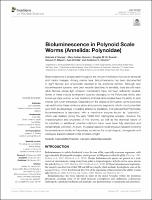Please use this identifier to cite or link to this item:
https://hdl.handle.net/20.500.12202/9626Full metadata record
| DC Field | Value | Language |
|---|---|---|
| dc.contributor.author | Moraes, Gabriela V. | |
| dc.contributor.author | Hannon, Mary Colleen | |
| dc.contributor.author | Soares, Douglas M. M. | |
| dc.contributor.author | Stevani, Cassius V. | |
| dc.contributor.author | Schulze, Anja | |
| dc.contributor.author | Oliveira, Anderson G. | |
| dc.date.accessioned | 2023-12-12T14:38:52Z | |
| dc.date.available | 2023-12-12T14:38:52Z | |
| dc.date.issued | 2021 | |
| dc.identifier.citation | Gabriela V. Moraes, Mary Colleen Hannon, Douglas M. M. Soares, Cassius V. Stevani, Anja Schulze, & Anderson G. Oliveira. (2021). Bioluminescence in Polynoid Scale Worms (Annelida: Polynoidae). Frontiers in Marine Science, 8. https://doi.org/10.3389/fmars.2021.643197 | en_US |
| dc.identifier.issn | 2296-7745 | |
| dc.identifier.uri | https://doaj.org/article/0141dfaa6f684d7b9d12bd2ab7142209 | en_US |
| dc.identifier.uri | https://hdl.handle.net/20.500.12202/9626 | |
| dc.description | Scholarly article / OA. [NOTE: The Supplementary Material for this article can be found online at: https://www.frontiersin.org/articles/10.3389/fmars.2021.643197/full#supplementary-material] | en_US |
| dc.description.abstract | Bioluminescence is widespread throughout the phylum Annelida and occurs in terrestrial and marine lineages. Among marine taxa, bioluminescence has been documented in eight families and anecdotally reported in six additional families. Although new bioluminescent systems have been recently described in annelids, there are still many other families whose light emission mechanisms have not been sufficiently studied. Some of these include luminescent species belonging to the Polynoidae family, also known as scale worms, whose iterations of dorsal elytra (scales) have the ability to emit intense light when stimulated. Depending on the degree of stimulation, some polynoids can autotomize these luminous elytra and posterior segments, which could potentially give them an advantage in evading attacks by predators. It is believed that Polynoidae bioluminescence is associated with a membrane enzyme known as “polynoidin,” which was isolated during the early 1980s from Malmgrenia lunulata. However, the characterization and properties of this enzyme, as well as the chemical nature of its substrate or additional potential cofactors, have never been fully described and remain largely unknown. As such, this paper seeks to revisit previous research involving bioluminescence studies in Polynoidae, as well as the morphological, phylogenetic and ecological aspects related to this emission of light. | en_US |
| dc.description.sponsorship | Funding Funding for this project was provided by the São Paulo Research Foundation (FAPESP) (AO, DS, and CS 2017/22501-2, AO 2018/22304-5 and 2020/07600-7, GM 2019/25086-1, and DS 2019/12605-0) and TAMU FAPESP Collaborative Grant Program (project number: 2018-3-09) which supported AS and MCH. | en_US |
| dc.language.iso | en_US | en_US |
| dc.publisher | Frontiers Media S.A., 2021. | en_US |
| dc.relation.ispartofseries | Frontiers in Marine Scienc;8 | |
| dc.rights | Attribution-NonCommercial-NoDerivs 3.0 United States | * |
| dc.rights.uri | http://creativecommons.org/licenses/by-nc-nd/3.0/us/ | * |
| dc.subject | bioluminescence | en_US |
| dc.subject | marine annelids | en_US |
| dc.subject | Polynoidae | en_US |
| dc.subject | scale worm | en_US |
| dc.subject | photoprotein | en_US |
| dc.subject | polynoidin | en_US |
| dc.subject | Science | en_US |
| dc.subject | General. Including nature conservation, geographical distribution | en_US |
| dc.subject | QH1-199.5 | en_US |
| dc.title | Bioluminescence in Polynoid Scale Worms | en_US |
| dc.type | Article | en_US |
| dc.identifier.doi | https://doi.org/10.3389/fmars.2021.643197 | en_US |
| dc.contributor.orcid | 0000-0003-1752-0726 | en_US |
| local.yu.facultypage | https://www.yu.edu/faculty/pages/oliveira-anderson | en_US |
| Appears in Collections: | Stern College for Women -- Faculty Publications | |
Files in This Item:
| File | Description | Size | Format | |
|---|---|---|---|---|
| Oliveira OA 2021 Bioluminescence in polynoid scale.pdf | 529.93 kB | Adobe PDF |  View/Open |
This item is licensed under a Creative Commons License

